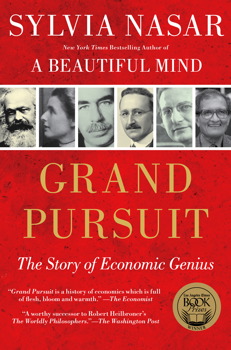 Billed as “the epic story of the making of modern economics,” journalism professor and former New York Times economics columnist Sylvia Nasar’s book Grand Pursuit offers an interesting portrait of some of the most important economic thinkers of the past 150 years.
Billed as “the epic story of the making of modern economics,” journalism professor and former New York Times economics columnist Sylvia Nasar’s book Grand Pursuit offers an interesting portrait of some of the most important economic thinkers of the past 150 years.
Emphasis should be placed on the word “some,” since Nasar clearly limits her profiles to selected figures in economic history. Her story starts well after Adam Smith, as she devotes her first full chapter largely to Karl Marx and Friedrich Engels. Of course, that selection raises a red (pun intended) flag, but Nasar isn’t out to bolster sales of Das Kapital. Since her work offers as much or more biography as description of economic theory, we learn that Marx’s work habits and intellectual curiosity left much to be desired. This reader took away the impression that Marx was a bit of a lazy moocher, stringing the wealthier and more stridently radical Engels along for as long as possible without actually doing any work to bolster their “worker’s revolution.”
Readers might wonder why Nasar chose particular economists to dissect: Keynes is there, as are Hayek, Friedman, Schumpeter, Paul Samuelson, Alfred Marshall, and Irving Fisher. But why spend so much time on Beatrice (Potter) Webb or Joan Robinson? Why devote the final chapter to an obviously awe-inspired discussion of the Indian economist Amartya Sen? The answers are not particularly clear.
But Nasar deserves credit for describing each thinker’s ideas fairly. One of this reader’s favorite passages involves Alfred Marshall.
Marshall’s obsessive effort to understand how business worked led to his most important discovery. The economic function of the business firm in a competitive market was not only or even primarily to produce profits for owners. It was to produce higher living standards for consumers and workers. How did it do this? By producing and distributing more goods and services of better quality and at lower cost with fewer resources. Why? Competition forced owners and managers to constantly improve their products, manufacturing techniques, distribution, and marketing. The constant search to find efficiency gains, economize on resources, and do more with less resulted over time in doing more with the same or fewer resources. Multiplied over hundreds of thousands of enterprises throughout the economy, the accumulation of incremental improvements over time raised average productivity and wages. In other words, competition forces businesses to raise productivity in order to stay profitable. Competition forced owners to share the fruits of these efforts with managers and employees, in the form of higher pay, and with customers, in the form of higher quality or lower prices.


